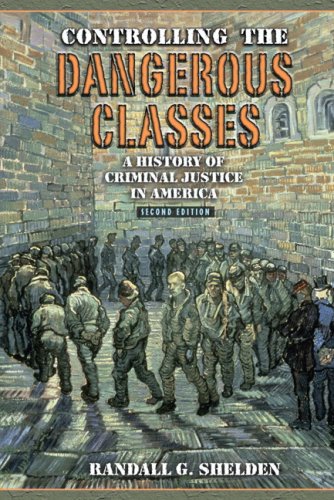Test Bank For Controlling the Dangerous Classes: A History of Criminal Justice in America (2nd Edition) 2nd Edition
$35.00 Original price was: $35.00.$26.50Current price is: $26.50.
Test Bank For Controlling the Dangerous Classes: A History of Criminal Justice in America (2nd Edition) 2nd Edition
This is completed downloadable of Test Bank For Controlling the Dangerous Classes: A History of Criminal Justice in America (2nd Edition) 2nd Edition

Product Details:
- ISBN-10 : 1478634863
- ISBN-13 : 978-1478634867
- Author: Randall G. Shelden (Author), Pavel V. Vasiliev (Author)
Throughout history, the powerful have created laws, developed agencies to enforce those laws, and established institutions to punish lawbreakers. Maintaining the social order to their advantage resulted in the systematic repression of disadvantaged groups the “dangerous classes.” The third edition retains a historical approach to exploring patterns of social control and, through current examples, demonstrates how those strategies continue today.
The authors trace the roots of race, class, and gender bias in how laws are written, interpreted, and applied. The management of dangerous classes is not a recent phenomenon; there is a long history of keeping those who derive the least advantage from the status quo (and therefore pose the greatest threat) under control. There was and is one system of justice for the privileged and a very different system for the less privileged. The criminal justice system from the law to daily operations of the police, courts, and corrections generally comes down hardest on those with the least amount of power and influence and is the most lenient with those with the most power and influence.
The book raises critical questions. What is a crime? What is law? Whose interests are served by the law and the criminal justice system? What patterns are repeated generation after generation? How does the criminal justice system relate to larger issues such as social inequality, social class, race, and gender? Contemplation of these topics contributes to informed public dialogue and careful deliberation about the present state and the future of criminal justice.
Table of Content:
- Chapter One – Perpetuating the Class System: The Development of Criminal Law
- Criminal Law in Ancient Times
- Emergence of Criminal Law in Athens
- Criminal Law in Rome
- Acephalous Societies and Law
- Criminal Law in Medieval Times
- Emergence of Criminal Law in England
- Criminal Law as an Ideological System of Control
- Emergence of the Concept of Crime
- The Law of Theft
- The Law of Vagrancy
- Emergence of Criminal Law in the United States
- Racism and the Law
- The Tramp Acts
- Controlling the Dangerous Classes through Drug Laws
- Opiates
- Cocaine
- Marijuana
- Crack Cocaine
- The Impact of Drug Laws
- Some Progress
- Whose Interest Does the Law Serve?
- Notes
- Chapter Two – The Development of the Police Institution: Controlling the Dangerous Classes
- Early Police Systems
- The Emergence of the Police Institution in England
- The Metropolitan Police of London
- Sir Robert Peel
- The Development of the Police Institution in the United States
- Buffalo, New York
- The Rise and Growth of Private Policing
- The Growth of the Police Institution in the Twentieth Century
- The Progressive Era
- Policing the Ghetto in the 1960s
- Policing Strategies
- Community Policing
- Predictive Policing
- Police Corruption: A Continuing Problem
- Federal Corruption
- Law Enforcement Corruption in Major Cities
- Controlling the Dangerous Classes through the War on Drugs
- Abuse of Power
- Stop-and-Frisk
- Deadly Force
- The Militarization of Policing
- Notes
- Chapter Three – Processing the Dangerous Classes: The American Court System
- Introduction
- The Development of the Modern Court System: The Colonial System
- Elite Dominance of the Legal Profession in Colonial America
- The Justice of the Peace in Colonial America
- Processing Criminal Cases: Public versus Private Prosecution
- Upholding Morality
- Hunting for Witches and Religious Dissidents
- After the Revolution
- The Federal System and the Supreme Court
- Post-Civil War Changes in the Court System
- Detaining the Rabble
- The Right to Counsel
- Traditional versus Radical-Criminal Trials
- The Traditional Criminal Trial
- Challenging the System
- The Modern Era: The War on Drugs
- Supreme Court Cases
- Drug Courts
- Sentencing and Plea Bargains
- The Ultimate Sanction: The Death Penalty
- Application of the Death Penalty after Furman
- Racial Disparities
- Evolving Standards
- Wrongful Convictions
- Notes
- Chapter Four – Housing the Dangerous Classes: The Emergence and Growth of the Prison System
- Imprisonment as Punishment
- The Trafficking of Offenders
- Early Capitalism and the Emergence of the Workhouse
- Late Eighteenth Century Reforms and the Birth of the Prison System
- The Development of the American Prison System
- The Walnut Street Jail
- The Pennsylvania and Auburn Systems of Penal Discipline
- The Rise of the Reformatory
- Convict Labor
- Convict Leasing
- Slavery by Another Name
- Prison Reform during the Progressive Era
- Inmate Self-Government
- Classification, Diagnosis, and Treatment
- The Decline in Prison Industries
- The Big House
- The Emergence of the Federal Prison System and “Correctionalists”
- The Federal Prison System
- The System of “Corrections”
- The Modern Era, 1980 to the Present
- Warehousing
- The New American Apartheid
- The American Gulag
- Notes
- Chapter Five – Controlling the Young: The Development of the Juvenile Justice System
- The Invention of Childhood
- Little Adults
- Literacy
- Schools
- Children in the Colonies
- Parens Patriae
- Defining a Juvenile Delinquent
- The House of Refuge Movement
- Early Nineteenth Century Conceptions of Delinquency
- Ex Parte Crouse
- People v. Turner
- Mid-Nineteenth Century Reforms
- Late-Nineteenth Century Reforms
- The Child-Saving Movement
- The Juvenile Court
- The San Francisco Industrial School
- Public Schools and Social Control
- Science in Service of Solutions
- The Eugenics Movement
- Biological Factors Predicting Violence
- Twentieth-Century Developments in Juvenile Justice
- Supreme Court Rulings
- Disproportionate Minority Contact
- Juvenile Justice in the Twenty-First Century
- Facilities, Arrests, and Placements
- Disproportionate Minority Contact Revisited
- Zero Tolerance Policies
- School to Prison Pipeline
- Kids for Cash
- Sentencing Decisions
- Harmful Practices
- Notes
- Chapter Six – Perpetuating Patriarchy: Keeping Women in Their Place
- Women and the Law
- Patriarchy
- Images of Women
- Punishing and Controlling Women
- A History of Women’s Prisons
- The Emergence of Women’s Reformatories
- The Role of Racism
- Controlling Women’s Bodies and Sexuality
- Girls and the Juvenile Justice System
- Keeping Girls in their Place: The Development of Institutions for Girls
- The Child-Saving Movement and Girls
- “The Best Place to Conquer Girls”
- The Juvenile Court and the Double Standard of Juvenile Justice
- Women and Criminal Justice Today
- Sentencing Patterns and the War on Drugs
- Criminalizing Pregnancy
- Women in Today’s Prisons and Jails
- Female Offenders and Their Children
- Background Characteristics of Women in Prison
- Women in Jail
- Notes
- Chapter Seven – Crime Control: Profiting from Controlling the Dangerous Classes
- Formal versus Informal Social Control
- Group Threat Theory
- Coercive Mobility
- The Crime Control Industry
- The Prison-Industrial Complex: Cashing in on Crime
- Reach Out and Touch Someone
- Pay to Stay
- Rural Prisons: Uplifting Rural Economies?
- Exploiting Prisoners to Enhance Rural Populations
- What Happens if a Prison Closes?
- Prison Labor: Auburn Plan Revisited
- The Privatization of Prisons: More Profits for Private Industry
- Some Serious Problems with Privatization
- Private Security: Crime Is Good for Business
- Notes
- Chapter Eight – Where Do We Go from Here?
- Governing through Crime
- The Importance of the Economy
- American-Style Capitalism Is the Real Culprit
- Downsizing and Outsourcing the American Dream
- The Growth and Perpetuation of the Dangerous Classes
- We Need Big Changes
- National Strategy
- Restorative Justice
- Procedural Justice
- Justice Reinvestment
- Decarceration
- So What Can I Do, You Ask?
- Notes
- References
- Index
People Also Search:
controlling the dangerous classes: a history of criminal justice in america
controlling the dangerous classes: a history of criminal justice in america 2nd edition
controlling the dangerous classes: a history of criminal justice in america 2nd edition download scribd
controlling the dangerous classes: a history of criminal justice in america 2nd edition test bank download pdf











